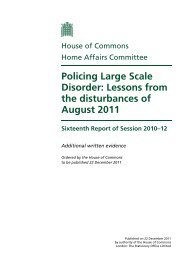Murder and Serious Sexual Assault - Lancaster EPrints - Lancaster ...
Murder and Serious Sexual Assault - Lancaster EPrints - Lancaster ...
Murder and Serious Sexual Assault - Lancaster EPrints - Lancaster ...
You also want an ePaper? Increase the reach of your titles
YUMPU automatically turns print PDFs into web optimized ePapers that Google loves.
5. Unusual previous offences<br />
UNUSUAL PREVIOUS OFFENCES<br />
This chapter considers in more depth those convicted of murder or SSA who had<br />
less common offences in their background. In particular, it focuses on those previous<br />
offences for which less than two per cent of either murderers or serious sexual<br />
offenders had convictions, but which were nevertheless statistically significantly<br />
different from the controls. Of course, the very nature of ‘unusual’ offences means<br />
that the number of cases is often limited <strong>and</strong> this needs to be considered in assessing<br />
the inferences that follow.<br />
Offenders convicted of murder<br />
Using the criteria for ‘unusual offences’, it was found that convictions for<br />
manslaughter, kidnapping, blackmail, soliciting by a man <strong>and</strong> adulteration of<br />
food/drugs significantly increased the relative risk of murder. Manslaughter was the<br />
most clear-cut <strong>and</strong> perhaps most predictable. The possible links between<br />
kidnapping, blackmail, soliciting by a man <strong>and</strong> adulteration of food/drugs with<br />
subsequent convictions for murder are more intriguing, <strong>and</strong> several of these are<br />
examined in more detail.<br />
A previous conviction for manslaughter was shown to be statistically significant for<br />
murder (see Table 6), <strong>and</strong> those with such a conviction are over 19 times as likely to<br />
be subsequently convicted of murder. Five murderers <strong>and</strong> one general control had<br />
manslaughter in their history. As there were approximately four controls to every<br />
murderer, it would be expected that if cases <strong>and</strong> controls were similar, there would<br />
be around 20 offenders with manslaughter convictions among the controls.<br />
However, a conviction for manslaughter did not significantly distinguish murderers<br />
from violent controls.<br />
A previous conviction for kidnapping was shown to be a statistically significant risk<br />
factor for murder, both when compared against general criminal controls <strong>and</strong> against<br />
violent controls. Focusing on the offender-victim relationship reveals that<br />
kidnapping is only a significant risk factor for subsequent male stranger murders. In<br />
fact, of the six murderers with a previous conviction for kidnapping, three had<br />
murdered a male stranger (of the others, two had murdered a male acquaintance <strong>and</strong><br />
one had murdered a female stranger). There is no evidence that anyone with<br />
kidnapping in their history murdered a family member. Furthermore, for all cases,<br />
the murder conviction was within six years of the kidnapping conviction.<br />
33
















